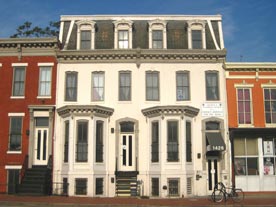
Thanks to an economic development program of the FHLBank of Atlanta, Emmaus Services for the Aging was able to open this community space for seniors in a rehabilitated, formerly abandoned home in the Shaw neighborhood of Washington, D.C. Photo by rock_creek via Flickr, CC BY-NC-SA
In this difficult economic time, community economic development practitioners need to leverage every dollar. Congress is currently considering substantial reform of the housing finance system, including not only Fannie Mae and Freddie Mac but also major changes to the Federal Home Loan Banks (FHLBanks). Too often, the FHLBanks are neglected or misunderstood in the debate on housing finance policy, but they can and should play a major, and even increased role, in supporting our communities.
FHLBanks 101
Nationwide, there are 12 independent regional Federal Home Loan Banks. These government-supported enterprises were created by the Federal Home Loan Bank Act of 1932 to support mortgage lending and related community investment. Each bank is structured as a cooperative of its member financial institutions, and the whole system has more than 8,000 members. The FHLBanks and the system as a whole are regulated by the Federal Housing Finance Agency (FHFA).
As GSEs, the FHLBanks receive certain privileges that enable them to raise funds at rates significantly below the rates in the private markets. Bank members benefit not only from dividends, but also from access to low-cost financing known as advances, which they use to finance mortgage loans and housing and community economic development investments, as well as to maintain liquidity for operations.
In exchange for the benefits conferred by their status as GSEs, the FHLBanks have a responsibility to invest in affordable housing and community economic development. By law, all FHLBanks operate a Community Investment Program (CIP) to meet community needs. In recent years, FHFA also established Community Investment Cash Advance (CICA) programs, which are voluntary, though all FHLBanks have set one up. Any member institution can access funds through its FHLBank’s CIP or CICA program upon request. There is no cap on the amount of fixed-rate, long-term financing available to each FHLBank, although some banks do set a cap for their members.
Many great projects have been funded through these programs (see sidebar, Economic Development at FHLBanks), and yet, the overall level of investment in community economic development has been anemic. Since 1990, the FHLBanks provided $2 trillion in advances, but only $16 billion of those were for investments in community economic development in targeted communities. This only created 164,264 jobs.
On the other hand, many housing developers are familiar with the FHLBanks’ Affordable Housing Program, which requires each FHLBank to set aside 10 percent of annual profits to invest in local affordable housing initiatives. The results have been incredibly positive: since 1990, more than $4.2 billion in grants, which have helped create more than 700,000 housing units. AHP has become “the crown jewel of the system” according to many sources, as it brings strong housing development proposals together with appropriate financing. AHP is the largest source of private funds for affordable housing in the nation.
While AHP’s total disbursements are smaller than the total listed above for economic development, AHP funds are grants, while the economic development funds are loans and should be part of the banks’ core business even without special programs. While some FHLBanks operate small grant programs for economic development, like San Francisco’s AHEAD program or the FHLBank of Pittsburgh’s Banking on Business program, the majority do not. Others, like Atlanta’s EDGE program, operated for only a few years before being abandoned. To improve community economic development investments, three clear steps are required:
Improve Oversight of Community Lending Plans
Each FHLBank publishes an annual Community Lending Plan and Affordable Housing Advisory Council Annual Report. These public reports detail the goals and outcomes that each FHLBank has established for its affordable housing and community economic development activities.
Community Lending Plans describe the FHLBanks’ annual goals for community investment through CICA and any additional programs unique to a particular FHLBank. The Affordable Housing Advisory Council reports cover each FHLBank’s annual AHP outcomes. Unfortunately, these documents are not uniform and fail to consistently track the same information using standardized methodologies or consistent and well-defined terms.
Community Lending Plans in particular, often do not track outcomes at all, and if they do, they present achievements and goals that do not match. For example, a particular FHLBank may set a goal of approving 30 small business projects, 50 small farm projects, and 10 small agribusiness projects for the upcoming year, and later report only that 126 community development projects were approved, without breaking down the results by project type. Funding information is often provided for several programs in aggregate, and the reports often do not differentiate between funds allocated, funds awarded, and funds actually used.
The FHFA should make it easier for the public to track and understand the impact of FHLBank investments. In addition, FHFA should itself use these reports to measure how successfully the FHLBanks meet the need for community economic development investments.
Strengthen the Community Support Review
FHFA does review the community economic development activities of FHLBanks’ member institutions through its Community Support Program. Each quarter, FHFA selects a portion of the members of each bank for a Community Support Review. The members must submit Community Support Statements to FHFA detailing their community activities and investments. These statements are in addition to their Community Reinvestment Act obligations. The penalties for a member whose CSS is found to be inadequate is loss of access to FHLBank advances and to the AHP, CIP, and CICA programs.
Few local governments or organizations weigh in on these statements, however. The banks keep a list of groups who should receive the quarterly review information, and community organizations and local governments should get on that list and respond.
A Community Economic Development Version of AHP
The best way to increase investment in community economic development is to mandate it, using the AHP model — setting aside a percentage of FHLBanks’ annual profits for investment in community economic development projects identified by member financial institutions.
The voluntary programs are not enough. CIP and CICA are relatively unknown to the FHLBanks’ member institutions and not as easy for a financial institution to offer. Frequent staff changes within institutions result in loss of memory of how these programs work. As a result, CIP and CICA are greatly underutilized. The occasional programs of a particular FHLBank can be difficult to promote and understand, especially if they change frequently. In comparison, the permanent infrastructure and funding stream of AHP makes this program relatively easy for community groups to access and for FHLBank members to use.
An economic development version of AHP would feature the same type of annual competition for grants that has successfully increased the banks’ affordable housing investments. Submitting proposals together encourages local nonprofits, governments, and tribes to build reliable partnerships that can work together over a period of years. Bringing financial institutions to the table early in the process allows the partners to adapt and respond to lenders’ interests and concerns, enabling projects to attract greater financing later.
Such a community economic development program would maintain decision-making and prioritizing capacity at the regional level through each FHLBank’s advisory council. Funds could be disbursed as grants or invested as loan guarantees or equity investments for retail, commercial, or industrial facilities that provide quality jobs for workers who are unemployed, disadvantaged, or earn low wages. They could also be used to invest in microenterprise organizations, including CDFIs. Other eligible uses would include mixed-use developments, resident conversion of manufactured home communities, and funding for pre-development costs. Like AHP funds, community economic development program funds would also count as local matching dollars for state and federal programs, leveraging investments.
Where Would the Money Come From?
Unlike Fannie Mae and Freddie Mac, the FHLBanks have no federal income tax liability. They currently pay two taxes: the set-aside of 10 percent of annual profits for AHP and the set-aside of 20 percent of annual profits to repay the obligations of the Resolution Funding Corporation (REFCORP). REFCORP was established in 1990 to offset the U.S. government’s losses from the savings and loan crisis of the late 1980s. In 2010, the FHLBanks repaid a total of $498 million to REFCORP. The FHLBanks are expected to complete the repayment of all REFCORP obligations by the end of June 2011.
In the wake of the financial crisis, the FHLBanks have sustained new losses on their investment portfolios and many are currently undercapitalized. Recently, the 12 FHLBanks released a joint agreement, endorsed by their regulator, FHFA, to retain up to 20 percent of annual profits after REFCORP is repaid in a restricted account until the account value is equal to 1 percent of the bank’s total consolidated obligations. After that, each bank would set aside as much of its annual profit as necessary to maintain the restricted account at that 1 percent level. The balance of profits could be used at the bank’s discretion, most likely to pay dividends.
Although improving the FHLBank system’s impaired capital is a worthy objective, the system’s mission requirement is just as important, and the FHLBanks’ joint agreement does not address their responsibility to meet the nation’s need for jobs and economic growth.
Rather than have the entire balance go to dividends after the reserve accounts are funded, the below organizations support a set-aside of 15 percent of profits for a community economic development grant program:
- Corporation for Enterprise Development
- Community Assets for People LLC (WI)
- Opportunity Finance Network
- National Association of Development Organizations
- National Association of Regional Councils
- National Association of Latino Community Asset Builders
- National Association for Community Economic Development Associations
- Wall Street Without Walls
In this time of overwhelming budget cuts, high levels of unemployment and global economic change, a long-term, significant funding source that brings together community development organizations, local governments, and the financial sector could play a crucial role to building a stronger, more inclusive economy.
Sofya Leonova and Katherine Lucas-Smith contributed to this article.




Comments